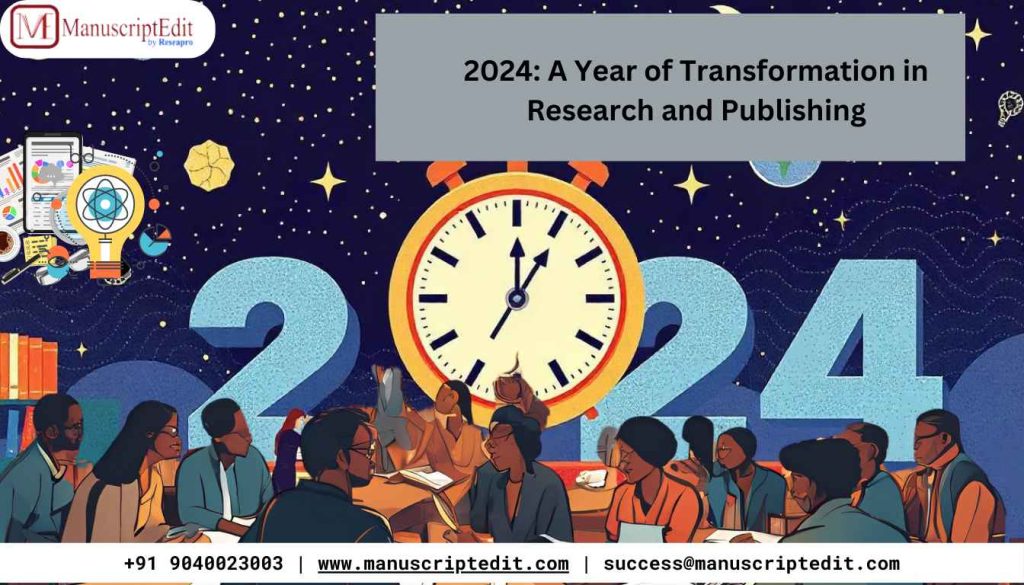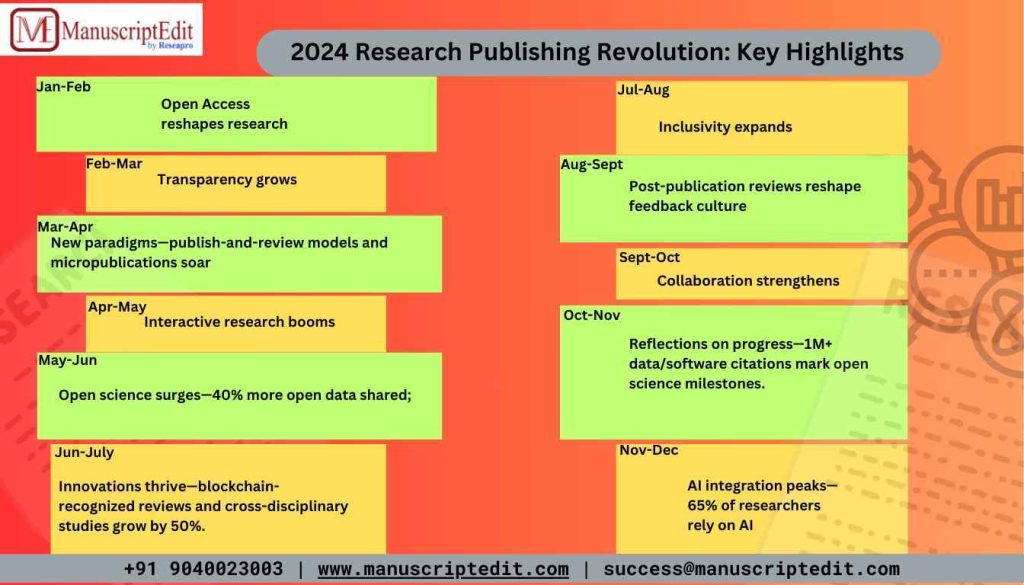|
Getting your Trinity Audio player ready...
|

At midnight in 2024, the global research community was in for a significant shift. With technology accelerating faster than ever and much more focus on open science, this year marked an important moment in how knowledge is created, shared, and used. From major new ideas to changes in the way research is published, 2024 saw quite a lot of developments change the research world. Let’s take a month-by-month trip to look at these important changes in the research and publishing dynamics.

January-February 2024: Open Access Goes Mainstream
A significant event to start with this year is the total implementation of Plan S, led by a consortium of funding agencies, which dictates that all research funded through the public in participating countries must be published in open access journals. Plan S would break paywalls and put readers, students, among other members of the general public, abreast with the latest research, spreading knowledge to everyone in the world. By the end of February, more than 75% of publicly funded research in Europe followed Plan S rules, showing a big change in accessibility.
In January with the imposition of rules around AI-generated content in submissions the researchers were required to report whether and how AI tools had aided them in the work. A survey conducted at the end of the year reported that 62% of submissions to Nature during the first quarter contained some use of AI, an indication of the growing involvement of AI in research work.
At the same time, many big publishers have improved their rules for preprints, connecting early research with official publications. The number of preprint submissions rose by 40% in the first two months of 2024 as compared to the same period of 2023, thus indicating how fast this practice is being accepted.
February-March 2024: Technology and Transparency Take Center Stage
Public Library of Science (PLOS) said that it will be requiring its authors to share data upon the publication of their work in its journals. It stated that this was one step further in being increasingly transparent and reproducible in the course of research. According to PLOS, the number of datasets shared has increased by 35% compared to last year.
Blockchain technology gained popularity, and many big publishers started using blockchain systems to track and check peer reviews. Such systems gave a clear and permanent record of the review process, making it easier to hold people accountable and building trust in scientific publishing. By March, more than 1,200 journals had started using blockchain-based peer-review tracking, handling millions of reviews each year.
Advanced AI detection systems were therefore put in place to check submissions by publishers against misuse of generative AI tools in manuscript preparation. In their first applications, these tools flagged as much as 8% of manuscripts for possible misuse, and this demonstrates just how vital they are in preserving research integrity.
March-April 2024: A Shift in Publishing Paradigms
The spring months of March and April were when the publishing world welcomed a revolutionizing trend: the “publish and review” model. Articles would be published first, before proper peer review, but would still allow the rapid diffusion of results. By April, more than 500 journals had already switched to this model, representing tens of thousands of articles published under this system.
The micropublication format was also on the rise, as this format allowed researchers to publish specific findings or datasets without waiting for a full-length study. This is very useful in fast-evolving fields like medicine and climate science, where new information is constantly being added. Micropublications were up 60% over 2023.
Major journals imposed strict authorship contribution requirements. It helped in clearly defining each role of an author, hence avoiding a credit dispute. In fact, according to a recent analysis, 85% of the respondents are supportive of changes made with the most frequently mentioned reasons being increased transparency and accountability.
April-May 2024: Interactive and Reproducible Research
By April, better publication formats with interactive data visuals became more common. These formats changed static research papers into lively, engaging experiences, helping readers to understand complex findings more easily. Over 300 journals had interactive visuals in 2024, with reader engagement metrics showing a 25% increase compared to traditional formats.
Focus on reproducibility also became much stronger. Journals required open sharing of methods and data. This effort was aimed at fixing the reproducibility problem affecting many areas with early surveys showing a 15% increase in repeatable studies published in the first half of 2024.
Community-driven peer review platforms began to appear during this period. They created spaces in which researchers could collaborate with each other in evaluating their work, bringing diverse perspectives to the review process, and hence enhancing the quality of studies published. Over 20000 reviews were conducted by May on such platforms, thus showing its growing impact.
May-June 2024: Open Science in the Spotlight
As spring turned to summer, the global research community embraced open science practices more fervently than ever. Journals placed greater emphasis on transparency, integrity, and accessibility. Researchers were encouraged to share not only their findings but also their raw data, codes, and methodologies. A study estimated that open data availability increased by 40% year-over-year during this period.
AI tools became integral to editorial and peer review processes, streamlining workflows and reducing human biases. These tools assisted editors in identifying suitable reviewers, detecting potential ethical issues, and ensuring compliance with submission guidelines. Preliminary data indicated that AI reduced editorial decision times by an average of 20%.
Additionally, alternative metrics for measuring research impact gained traction. Beyond traditional citation counts, metrics such as societal influence, policy adoption, and real-world applications began to shape how research impact was assessed. By June, over 50% of institutions reported incorporating alternative metrics into their evaluation frameworks.
June-July 2024: Innovations in Publication Models
The middle of the year saw a great surge in the adoption of the “publish-and-review” model, revolutionizing the traditional peer process. Now researchers could share their work immediately and get constructive feedback from the community, ensuring both speed and quality. By the middle of the year, articles published under this model made up about 10% of all scientific publications.
Blockchain-verified peer reviews became prominent, offering a transparent and tamper-proof system to track review contributions. These systems also rewarded reviewers with recognition and credits for their efforts. In July, more than 15,000 reviewers had been given blockchain-based credentials, which helped develop a culture of accountability.
We have witnessed very exciting progress in AI-assisted plagiarism detection systems that have evolved to better support honest research. The new tools can find hidden patterns of plagiarism, such as cases that use AI-generated text. In any case, it ensures original work stands out in published pieces. Early reports indicate a 30% increase in plagiarism cases over 2023, so be careful.
This makes it easier to publish studies involving other fields since big journals cut across many subjects. These journals are ideal in meeting the increased need for research that tackles difficult global problems with teamwork from different areas. By July, we saw a 50% rise in submissions to these big journals compared to last year!
July-August 2024: Multimedia and Inclusivity in Publishing
The summer months witnessed a surge in the use of multimedia supplements in traditional journals. Videos, animations, and interactive content accompanied research papers, providing richer contexts for complex ideas. Journals offering multimedia options reported a 35% increase in reader engagement and a 20% rise in citation rates.
To support non-native English speakers, AI-assisted language editing services started gaining much attention. The tools helped international researchers polish their manuscripts so that language barriers would not become a reason for the dissemination of valuable insights. By August, more than 200,000 manuscripts had been processed through these services globally.
Machine-readable formats became a standard requirement for submissions, making it easier to integrate the data with data analysis tools and increasing interoperability across platforms. The compliance rate was an impressive 85% in the first six months of implementation.
August-September 2024: Post-Publication Peer Review Gains Ground
Post-publication peer review platforms started to gain traction, allowing researchers to give feedback on published work. This model helped instill a culture of continuous improvement, enabling findings to be iteratively improved and expanded upon over time. By September, post-publication reviews were given to more than 15,000 papers—a clear sign of increasing community engagement.
Discipline-specific preprint servers began to emerge to serve niche fields that had been poorly served by traditional publishing platforms. Submissions to them grew by %, reflecting the growing importance of these in fostering collaboration within communities.
Better integration between institutional repositories and publishers smoothed out the lifecycle from submission to dissemination. By the end of this, more than 70% of repositories reported better interoperability with major publishers.
September-October 2024: Standards and Collaboration Take the Lead
Reproducibility continued to be a focus, with journals having tighter research methods and analysis standards. These were measures taken to deal with the reproducibility crisis; by 2024, reproducibility had reached a decade-high rate of 60%.
Policies were extended to include AI-generated content and analyses in recognition of AI’s increasing role within the research workflow. More than 25% of published articles during this period disclosed AI involvement—pointing to its transformative impact.
More collaborative peer review models started to gain traction, bringing diverse perspectives together in assessing manuscripts. Journals that adopted these models reported a 15% improvement in both review quality and author satisfaction.
October-November 2024: Reflecting on a Year of Change
As the year approached its end, journals and institutions conducted year-end assessments of open science initiatives. These evaluations highlighted successes and identified areas for improvement, ensuring continued progress in the years to come. Over 70% of journals reported meeting or exceeding their open science goals for 2024.
Citation practices evolved to include software and data citations, recognizing the importance of non-traditional research outputs. By November, over 1 million software and data citations had been recorded, marking a significant milestone in research acknowledgment.
November-December 2024: AI and the Future of Research
The final months of 2024 showcased the deep integration of AI into research workflows. From literature reviews to experimental design, AI tools transformed how researchers approached their work. Surveys showed that 65% of researchers used AI tools regularly, up from 50% in 2023.
Stakeholders have to embrace and adapt these innovations in order to be ahead. We invite you, our readers, to share your thoughts and engage with experts in the field as we all together shape the future of research. For researchers seeking support in navigating these changes, ManuscriptEdit offers expert research assistance, editing services, and guidance to ensure your work stands out.
Visit us today at www.manuscriptedit.com to find out how we can help you succeed in this fast-moving publishing landscape. We encourage your feedback as well and invite you to participate in the discussion of the future of research publishing!



